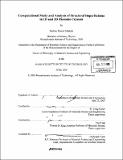Computational study and analysis of structural imperfections in 1D and 2D photonic crystals
Author(s)
Maskaly, Karlene Rosera
DownloadFull printable version (12.33Mb)
Other Contributors
Massachusetts Institute of Technology. Dept. of Materials Science and Engineering.
Advisor
W. Craig Carter and Yoel Fink.
Terms of use
Metadata
Show full item recordAbstract
Dielectric reflectors that are periodic in one or two dimensions, also known as 1D and 2D photonic crystals, have been widely studied for many potential applications due to the presence of wavelength-tunable photonic bandgaps. However, the unique optical behavior of photonic crystals is based on theoretical models of perfect analogues. Little is known about the practical effects of dielectric imperfections on their technologically useful optical properties. In order to address this issue, a finite-difference time-domain (FDTD) code is employed to study the effect of three specific dielectric imperfections in 1D and 2D photonic crystals. The first imperfection investigated is dielectric interfacial roughness in quarter-wave tuned ID photonic crystals at normal incidence. This study reveals that the reflectivity of some roughened photonic crystal configurations can change up to 50% at the center of the bandgap for RMS roughness values around 20% of the characteristic periodicity of the crystal. However, this reflectivity change can be mitigated by increasing the index contrast and/or the number of bilayers in the crystal. In order to explain these results, the homogenization approximation, which is usually applied to single rough surfaces, is applied to the quarter-wave stacks. (cont.) The results of the homogenization approximation match the FDTD results extremely well, suggesting that the main role of the roughness features is to grade the refractive index profile of the interfaces in the photonic crystal rather than diffusely scatter the incoming light. This result also implies that the amount of incoherent reflection from the roughened quarter-wave stacks is extremely small. This is confirmed through direct extraction of the amount of incoherent power from the FDTD calculations. Further FDTD studies are done on the entire normal incidence bandgap of roughened ID photonic crystals. These results reveal a narrowing and red-shifting of the normal incidence bandgap with increasing RMS roughness. Again, the homogenization approximation is able to predict these results. The problem of surface scratches on ID photonic crystals is also addressed. Although the reflectivity decreases are lower in this study, up to a 15% change in reflectivity is observed in certain scratched photonic crystal structures. However, this reflectivity change can be significantly decreased by adding a low index protective coating to the surface of the photonic crystal. Again, application of homogenization theory to these structures confirms its predictive power for this type of imperfection as well. (cont.) Additionally, the problem of acircular pores in 2D photonic crystals is investigated, showing that almost a 50% change in reflectivity can occur for some structures. Furthermore, this study reveals trends that are consistent with the D simulations: parameter changes that increase the absolute reflectivity of the photonic crystal will also increase its tolerance to structural imperfections. Finally, experimental reflectance spectra from roughened D photonic crystals are compared to the results predicted computationally in this thesis. Both the computed and experimental spectra correlate favorably, validating the findings presented herein.
Description
Thesis (Ph. D.)--Massachusetts Institute of Technology, Dept. of Materials Science and Engineering, 2005. Includes bibliographical references (p. 227-232).
Date issued
2005Department
Massachusetts Institute of Technology. Department of Materials Science and EngineeringPublisher
Massachusetts Institute of Technology
Keywords
Materials Science and Engineering.